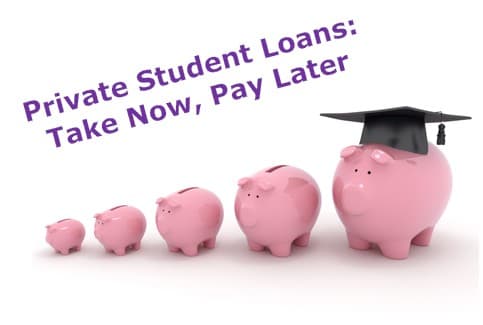Private Student Loan Relief | Default or ....?

Get rid of your debt faster with debt relief
Choose your debt amount
Or speak to a debt consultant 844-731-0836
- 8 min read
- The CFPB published in July 2012 a report about private student loans.
- There has been an improvement in procedures for taking out a private student loan.
- There are few relief options for private student loan borrowers in default.
- Start your FREE debt assessment
Is Private Student Loans Relief in Sight?
The news is out. Sub-prime private student loans were the rage during years 2005 – 2008. The CFPB in their July 2012 private student loan report, have come out with a long list of facts, and a few recommendations. Will that bring relief to the many private student loan borrowers struggling to make their payment? One area that the CFPB is attempting to rectify is "to be an informed consumer". You should know your options before taking a loan, and when repaying the loan. Student loans are complicated and have changed over time.
If you are struggling to pay your private student loans, then you realize that you have little relief in sight. Either pony up (or your co-borrower) or face a public judgment and the sanctions that follow: wage garnishments, bank levies, and liens on your personal property. You cannot even discharge your student loans in a bankruptcy, ever since 2005, when private student loans were equated to federal student loans.
Background: The Rise and “Fall” of Private Student Loans
Private Student Loans hit a peak of $20b in new loans during 2008. This is in contrast to the 2005 level of $5b, and the 2011 level of about $6b. Not only did the numbers grow, but also the lenders followed lax, sub-prime underwriting standards. The CFPB pointed out in their July 2012 private student loans report that:
Incomplete information and coordination was given to the students, resulting in some students taking out larger private loans than necessary. Many students were not aware of their rights or the total amount of federal assistance available.
Many lenders applied lax underwriting standards and did not take on co-borrowers. (The amount of loans in 2006 with co-borrowers was 67% and in 2011 90%). This means that many private student loan borrowers are left with huge payments, but no means to pay the loan. The CFPB noted lenders were not diligent in making sure borrowers knew how much they would owe at the end of the process.
Private student loans do not have relief programs similar to federal student loans including forbearance, income contingent payments and forgiveness. This leaves the borrower with little or no relief opportunities.
Quick Tip
Check the Dept. of Education’s National Student Loan Data System (NSLDS) to see if the loan is federal. State statutes of limitations do not apply to federal loans, and are subject to collection indefinitely. Student loans not backed by federal grants or guarantees do not appear in the NSLDS, and are therefore private. Private student loans are subject to state statutes of limitations.
Private Student Loan Relief - Taking a Loan
In 2010, the Obama Administration instituted major changes in the federal student program. Instead of having private lenders (like Sallie Mae) originate and service federal student loans, federal student loans are made through a Direct Loan program. The purpose of this is twofold:
- Save money by having the loans funded by federal funds and not subsidizing lenders.
- Clarify the borrowing process, so that students understand that they are taking federal loans or student loans. (Many borrowers are not sure if their Sallie Mae loan is federal or private).
One particular problem area is with for-profit institutions that saw a disproportionate amount of private student loans. These schools have an incentive to push students into private student loans due to federal funding requirements. The CFPB report notes:
“SOME GROUPS OF BORROWERS USED PRIVATE STUDENT LOANS SUBSTANTIALLY MORE THAN OTHERS. In 2008, 42% of undergraduates at for-profit colleges took out a private student loan, while only 14% of all undergraduates used a private student loan.”
Many of the problems of the 2005-2008 boom years have been rectified. This includes:

- Clearer process: The private student lender is supposed to make sure that the student understands their rights. The student should go through the FAFSA application and consult with a financial student counselor. When applying for a private student loan, the student presents their FAFSA self-certification form (PDF), which includes the total cost of schooling (tuition, books, living costs) and the amount of financial aid the student expects to receive. Private student loans are a last resort choice, and if taken may jeopardize your rights to federal financial funding.
- More co-borrowers: Private student lenders have tightened up their lending requirements, and in 2011-2012, 90% of the private student loans included a co-borrower. Since a private student loan is an unsecured loan (no collateral is offered), the credit score, income and net worth of a co-borrower is important. If there is a problem with the loan, then the co-borrower will most likely be the first one the lender turns to.
Know your payments: It is up to you! Remember, you must repay your loans, so make a plan. Justify the expense of your education and the loans you are taking, against the projected income you expect to receive from your degree. Sometimes, an expensive school is not your best choice. Private student loans often have a variable interest rate. That means you will not know your exact monthly payment. Many lenders offer an interest only or a grace period (which means that your interest is added to your principal). Make sure you keep a chart of all your student loan, the times that they become due (usually 6 months after finishing or leaving school), and the monthly payments.
Quick Tip
For more information about terms and conditions, including cosigning a private student loan, read the Bills.com article about taking private student loans.
Private Student Loan Relief - Repaying Your Loan
This is the stickler. If you have a private student loan, your repayment options are limited. You set up your schedule when you take out the loan, including interest only or grace periods, the number of payments, and the interest rate (which is often variable). The lender expects you to make those payments on time. If you have trouble paying, then the private student lender will most likely proceed with legal action against your and the co-borrower.
Problem #1: Co-borrower is responsible for loan.
- Solution: co-borrowers may have a chance to let themselves “off the hook” if you have a good credit score and refinance your loans (consolidate). You will need excellent credit and a clean payment history. Some lenders have programs that allow a co-borrower to be released. Read the fine print. There is no absolute guarantee, and in general, the student borrower must have a clean payment history, good credit and good income. Once you are late in your payments, then your co-borrower will be at risk for all the full amount of the loan. (Also, any late payments will be registered on their credit report and hurt their credit score).
Problem #2: Cannot afford the payment. Private student loans, beyond an initial grace and deferment payment plan do not allow for special modifications unlike federal student loans, which have special programs including deferment, forbearance, Income contingent payment, and forgiveness programs. If you are unable to pay your loan and default, then you will be subject to court judgments that lead to wage garnishments, bank levies, and liens.
- Solution: Although there is no specific solution to this problem there are a number of proposals including:
- Sec. of Education Durcan proposed that some private student loans be recognized as federal loans, and then could be eligible for Income Contingent Payment or forgiveness programs.
- Any solution would need either the cooperation of the lender, or government intervention. Since the private student loan 2005-2008 bubble has been compared to the sub-prime mortgage lending market; it is possible that pressure will be placed to make amends for a certain class of borrowers.
Problem # 3: Cannot discharge in bankruptcy. Private student loans, since 2005, cannot be included in bankruptcy, except for special hardship cases (which are very difficult to qualify for). The government offers federal student loans, despite the lack of credit worthiness, as a form of government assistance, therefore are exempt from bankruptcy. There were cases of students finishing school, and before beginning work, filing for bankruptcy and having all of their private student loans canceled. Therefore, the private student lenders pushed for a move to include private student loans in the same category. It is not a black and white situation. On one hand, lenders take extra security (co-borrowers) and are not obligated to give out loans. They can charge a market price for the risk they take, or not give out a loan. However, private student loans are unsecured loans that are generally of a more limited nature. It is argued that lenders will leave the market if the rules are changed.
- Solution: Pass legislation to allow private student loans to be included in bankruptcy, at least for a limited class of students.
- CFPB Director Cordray, proposed that Congress carefully examine allowing private student loans to be discharged in bankruptcy (either a total discharge in Chapter 7 or a payment plan in Chapter 13). Past attempts by Congress to change the bankruptcy laws, as pertains to student loans, have failed.
- There is currently a proposal by HR Hansen (HR 4170) which calls for a limited number of private student loans to be defined as federal student loans.
Quick Tip
If you have trouble paying your student loans, then check out the CFPB student debt repayment assistance tool.
Private Student Loan Relief: Not in Sight
Student debt has crossed the $1 trillion mark. There have been significant changes in the market since the 2005-2008 private student loan bubble (which many compare to the subprime mortgage bubble). There are have been improvements in information available when taking a loan, as well as a clearer address for all federal student loan, since the implementation of the Direct Loan program in 2010.
However, for those struggling to repay their private student loans, there is no immediate relief in sight. Although rare, some private student loan lenders have agreed to negotiate certain private student loans in a debt settlement agreement.
Relief may come for some select students through a private student loans forgiveness act, or a change in the bankruptcy laws. There is no doubt that the topic will remain in the news, so stay informed.

Get rid of your debt faster with debt relief
Take the first step towards a debt-free life with personalized debt reduction strategies.
Choose your debt amount
Or speak to a debt consultant 844-731-0836